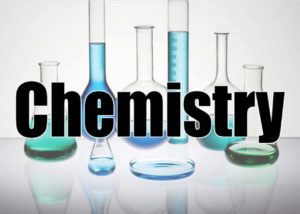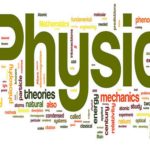120 Chemistry Quiz Questions Answers – Learn about Chemistry

Chemistry Quiz Questions Atomic Structure – Chemistry Questions 1- 30
Stanford University Department of Chemistry
1) Which quantum number gives the shape of the orbital?
Answer: Azimuthal quantum number.
2) What is the maximum capacity of d-orbital?
Answer: 10 electrons.
3) What is the shape of s-orbital?
Answer: Spherical.
4) What do you mean by Zeeman Effect?
Answer: Splitting of spectral lines by magnetic field.
5) What is the shape of p-orbital?
Answer: Dumb-bell.
6) Which series of hydrogen atomic spectrum lies in the visible region?
Answer: Balmer series.
7) Who proposed elliptical orbits?
Answer: Sommerfeld.
8) How many atomic orbitals are known? What are they?
Answer: Four. S, p, d, and f.
9) What is the maximum number of electrons that can be accommodated in an orbital?
Answer: 2.
10) How many orbitals present 5f subshell?
Answer: Seven.
11) On which property of electrons does the electron microscope work?
Answer: Wave nature.
12) The element with the minimum atomic number having 8 electrons in the outer most shell is what?
Answer: Neon.
13) The s-orbital of the L shell is represented as what?
Answer: 2s.
14) What is the maximum number of electrons in principal energy level?
Answer: K-2, L-8, M-18, N-32
15) What is the atomic number of the element which has 3 electrons in its M shell?
Answer: 13.
16) Which atom has only one electron?
Answer: hydrogen.
17) The path of the electron according to Niels Bohr’s theory was called what?
Answer: Orbit shell.
18) How many electrons can be accommodated in the M shell?
Answer: 18.
19) An electron jumps in to the next lower orbit when loses what?
Answer: One quantum of energy.
20) How many orbitals are there in p-subshell?
Answer: Three.
21) The various orbitals of the same subshell will differ in what?
Answer: In their direction orientation.
22) Electron is looked upon as a cloud of negative charge according to what?
Answer: Wave-mechanics theory.
23) The subshell consisting of dumb-bell shaped orbitals is known as what?
Answer: P-subshell.
24) The region of space around the nucleus where there is a high probability of finding an electron is called what?
Answer: Orbital.
25) The major shell-wise electronic configuration of element with the atomic number 15 is what?
Answer: 2, 8, 5
26) Who put forward the principle of uncertainty?
Answer: Werner Heisenberg.
27) When electron leaves an orbital and jumps in to another?
Answer: When its energy changes.
28) The electronic configuration of an atom is 2, 8, and 2. What is its atomic number?
Answer: 12.
29) What do you mean by orbitals?
Answer: They are regions of space around the nucleus where the probability of finding an electron is maximum.
30) What are the integers used to express the energy, posit, etc. of an electron?
Answer: Quantum numbers.
Chemistry Quiz Questions Chemical Equilibrium –
Chemistry Questions 31- 60
31) The steady state from which no spontaneous change takes place is called what?
Answer: Equilibrium.
32) What is the color of ammonium chloride?
Answer: White.
33) The chemical reactions which never go to completion are called what?
Answer: Reversible reactions.
34) In the manufacture of ammonia from hydrogen and nitrogen the pressure used is.
Answer: Very high.
35) The process of manufacture of Sulfuric acid is named as what?
Answer: Contact process.
36) What is the color of ferric thiocyanate?
Answer: Deep red or blood red.
37) What is known as a system of reacting substances in which the concentrations of reactants and product do not undergo any change?
Answer: Chemical equilibrium.
38) What is dissociation?
Answer: Reversible decomposition is called dissociation.
39) What is the color of Phenolphthalein in sodium hydroxide solution?
Answer: Pink.
40) Which substance obtained on cooling the vapor produced on heating ammonium chloride?
Answer: Ammonium chloride.
41) When temperature is decreased the speed of the reaction increases. Which was the action?
Answer: Exothermic.
42) Write an example of an irreversible reaction.
Answer: The neutralization of sodium hydroxide with hydrochloric acid.
43) A factor which is unable to alter the equilibrium state of reactions in which only solids or liquids are present is?
Answer: Pressure.
44) Chemical equilibrium is said to be dynamic in nature. Why?
Answer: Because even after reaching equilibrium forward and backward reactions are taking place at the same rate.
45) What must be constant for the system to reach equilibrium?
Answer: Temperature.
46) What do you understand by chemical equilibrium?
Answer: The stat of a system of reacting substances in which the concentration does not change is called chemical equilibrium.
47) What are the factors affecting the chemical equilibrium?
Answer: The changes in the concentration, temperature, or pressure affect the equilibrium.
48) Name the reactant used in excess in contact process?
Answer: Air.
49) What is the pressure used in the manufacture of ammonia?
Answer: 1000 atmospheres.
50) What is the optimum temperature in the manufacture of ammonia?
Answer: 500° C.
51) Name the scientist who described about reactions that go forward and backward.
Answer: Berthollet.
52) What is the color of solution obtained when hydrolysis of ferric chloride takes place?
Answer: Chocolate.
53) What is the name of process used for manufacturing ammonia direct from Nitrogen and hydrogen elements?
Answer: Haber process.
54) What accelerate the forward and backward reactions equally in a reversible reaction?
Answer: Catalyst.
55) What happens if a reversible reaction continues for a long time as a closed system?
Answer: Both the reactions continue at the same speed.
56) Which is the most suitable temperature for the production of sulfur trioxide from sulfur dioxide and oxygen?
Answer: 450° C.
57) What happens if a reversible reaction is allowed to continue uninterrupted?
Answer: It will finally reach a stage at which the concentrations of reactants and products remain without any change.
58) What happened if the concentration of the reactants is increased in a reversible reaction?
Answer: Concentration of the product increases.
59) Who put forward a principle relating to the equilibrium system?
Answer: Le Chatelier.
60) How is Le Chatelier principle useful to us?
Answer: It helps us to infer the effect of the change of concentration, pressure, or temperature on an equilibrium system.
Chemistry Quiz Questions Electrochemical Reactions – Chemistry Questions 61- 90
61) The substance which conducts electricity with the help of the ions present in them is called what?
Answer: Electrolytes.
62) Write the name of an anion.
Anion: Hydroxide ion.
63) Write the name of an insulator.
Answer: Glass.
64) Which is the best conductor of electric current?
Answer: Silver.
65) Which is the non-conductor of electricity?
Answer: Wood.
66) Which substance increases its electrical resistance on increasing temperature?
Answer: Metallic conductors.
67) Who gave the scientific explanation to the electrolytic reaction?
Answer: Faraday.
68) Which do not conduct electricity?
Answer: Non-Metals.
69) Which non-metal shows metallic conduction?
Answer: Graphite.
70) Which compound produced by anodic oxidation?
Answer: Potassium permanganate.
71) When sodium chloride solution is electrolyzed what is obtained at the anode?
Answer: Chlorine.
72) A substance which does not conduct electricity with the help of mobile electron?
Answer: Copper sulfate solution.
73) When a concentrated solution of copper sulfate is electrolyzed which ion gets discharged at the anode?
Answer: Hydroxide ion.
74) Which are the metals manufactured by electrolytic process?
Answer: Na, K, Ca, Mg, Al.
75) Which ions are attracted to the cathode?
Answer: Cations.
76) The atoms or groups of atoms that carry electrical charge are called what?
Answer: Ions.
77) Which chemical reactions take place in a torch cell?
Answer: Chemical energy is converted in to electrical energy.
78) Which is not a characteristic of metallic conductor?
Answer: Electrical conductivity increases with increase in temperature.
79) Which is obtained at the cathode when sodium chloride solution is electrolyzed?
Answer: Hydrogen.
80) Where does reduction take place?
Answer: At the cathode.
81) Which has greater ability to giveaway electron?
Answer: Sodium atom.
82) Chlorine is manufactured industrially by electrolysis of what?
Answer: Aqueous solution of sodium chloride.
83) A metal which is manufactured by electrolysis?
Answer: Sodium.
84) Which is obtained when potassium manganite solution is electrolyzed?
Answer: Potassium permanganate.
85) Electrolytic refining is used to refine what?
Answer: Copper.
86) Among hydroxyl ions and sulfate ions, which has more electron affinity?
Answer: Sulfate ions.
87) The conductivity of metal is due to what?
Answer: The flow of electrons.
88) A substance which is undergoes electrolytic conduction?
Answer: Fused sodium chloride.
89) The negative electrode is called what?
Answer: Cathode.
90) The electrolyte is suitable for electroplating nickel is what?
Answer: Nickel ammonium sulfate.
Chemistry Quiz Questions Periodic Classification – Chemistry Questions 91- 120
91) Which group contains the elements with the largest atomic size?
Answer: First group.
92) The electronegativity of cesium and francium according to Linus Pauling electronegativity scale is?
Answer: 0.7
93) What is mean by ionization energy?
Answer: Energy required to remove an electron.
94) What is the basis for modern classification of the elements?
Answer: Atomic number.
95) What kind of elements form co-ordination compound?
Answer: Transition metals.
96) What are the elements of second group called?
Answer: Alkaline earth metals.
97) Who was the first one to start the classification of elements?
Answer: Mendeleev.
98) Name two elements having low ionization energy.
Answer: Cesium and Francium.
99) Which element has the highest electron affinity?
Answer: Fluorine.
100) Which elements form large number of hydrides?
Answer: Carbon.
101) As the size of the atom increases the electronegativity?
Answer: Decreases.
102) How many elements are there in the sixth period?
Answer: 32
103) The gas given out when sodium is put in to water, evolves from?
Answer: Water.
104) What is mean by the word halogen?
Answer: Salt producer.
105) What kind of elements generally exhibit allotropy?
Answer: Nonmetals.
106) What is the total number of inner transition metals?
Answer: 28
107) What kind of elements occupy maximum in the Lothar Meyer curve?
Answer: Alkali metals.
108) What was the basis for Mendeleev classification of elements?
Answer: Atomic weight.
109) What kind of elements generally from colored compounds?
Answer: Transition metals.
110) Who studied the relationship between atomic volume and atomic weight?
Answer: Lothar Meyer.
111) What kind of elements have highest ionization energy?
Answer: Rare gases.
112) What are the first group elements called?
Answer: Alkali metals.
113) How many groups are there in the modern periodic table?
Answer: Eighteen.
114) What is the other name for f-block elements?
Answer: Inner transition metals.
115) Which gas is given out when sodium reacts with water?
Answer: Hydrogen.
116) How many periods are there in the Long form periodic table?
Answer: 7
117) Newland’s classification of elements was based on what?
Answer: Law of octaves.
118) The attempt to classify the elements as triad was made by whom?
Answer: Dobereiner.
119) Which property increases from group I to group VII?
Answer: Electronegativity.
120) The comprehensive classification of elements by Mendeleev was on the basis of the law known as what?
Answer: The periodic law.
Read : 118 Physics Quiz Questions Answers – Learn about Physics




very interesting and usefull…….
too good!!!!!